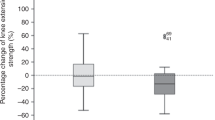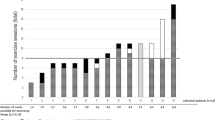Abstract
Patients who undergo hematopoietic SCT (HSCT) often experience physical and psychological problems, even long after treatment has been completed. This study was performed to evaluate the effects of a 12-week outpatient physical exercise (PE) program, incorporating aerobic and strength exercises, as compared with a usual care control condition on patients’ physical performance and psychosocial well-being. Patients who had completed HSCT up to 6 months earlier were randomly assigned to a supervised PE program (n=64) or a usual care control group (n=67). Primary outcomes were quantified physical performance and self-reported physical functioning. Secondary outcomes were body composition measurement, quantified walking activity and patient-reported outcomes (physical activity, fatigue and health-related quality of life). Assessments were at baseline, immediately after program completion and at 3-month follow-up. Significant intervention effects were observed at both posttreatment and follow-up on physical performance measures. No other outcomes yielded statistically significant group differences. PE should be considered in the management of HSCT recipients to improve physical performance after discharge from the hospital. Further research is needed to determine how the program can be enhanced so that improved physical performance also translates into improved physical and psychosocial functioning in daily life.
This is a preview of subscription content, access via your institution
Access options
Subscribe to this journal
Receive 12 print issues and online access
$259.00 per year
only $21.58 per issue
Buy this article
- Purchase on Springer Link
- Instant access to full article PDF
Prices may be subject to local taxes which are calculated during checkout

Similar content being viewed by others
References
Mosher CE, Redd WH, Rini CM, Burkhalter J, Duhamel K . Physical, psychological, and social sequelae following hematopoietic stem cell transplantation: a review of the literature. Psychooncology 2009; 18: 113–127.
Wiskemann J, Huber G . Physical exercise as adjuvant therapy for patients undergoing hematopoietic stem cell transplantation. Bone Marrow Transplant 2008; 41: 321–329.
Hjermstad MJ, Knobel H, Brinch L, Fayers PM, Loge JH, Holte H et al. A prospective study of health-related quality of life, fatigue, anxiety and depression 3-5 years after stem cell transplantation. Bone Marrow Transplant 2004; 34: 257–266.
Aaronson NK, Ahmedzai S, Bergman B, Bullinger M, Cull A, Duez NJ et al. The European Organization for Research and Treatment of Cancer QLQ-C30: a quality-of-life instrument for use in international clinical trials in oncology. J Natl Cancer Inst 1993; 85: 365–376.
McNeely ML, Campbell KL, Rowe BH, Klassen TP, Mackey JR, Courneya KS . Effects of exercise on breast cancer patients and survivors: a systematic review and meta-analysis. CMAJ 2006; 175: 34–41.
Thorsen L, Courneya KS, Stevinson C, Fosså SD . A systematic review of physical activity in prostate cancer survivors: outcomes, prevalence, and determinants. Support Care Cancer 2008; 16: 987–997.
McNeely ML, Parliament MB, Seikaly H, Jha N, Magee DJ, Haykowsky MJ et al. Effect of exercise on upper extremity pain and dysfunction in head and neck cancer survivors: a randomized controlled trial. Cancer 2008; 113: 214–222.
Jarden M, Baadsgaard MT, Hovgaard DJ, Boesen E, Adamsen L . A randomized trial on the effect of a multimodal intervention on physical capacity, functional performance and quality of life in adult patients undergoing allogeneic SCT. Bone Marrow Transplant 2009; 43: 725–737.
Baumann FT, Kraut L, Schüle K, Bloch W, Fauser AA . A controlled randomized study examining the effects of exercise therapy on patients undergoing haematopoietic stem cell transplantation. Bone Marrow Transplant 2010; 45: 355–362.
Shelton ML, Lee JQ, Morris GS, Massey PR, Kendall DG, Munsell MF et al. A randomized control trial of a supervised versus a self-directed exercise program for allogeneic stem cell transplant patients. Psychooncology 2008; 18: 353–359.
Somerfield MR, Rizzo JD . Can a modest exercise program really improve physical functioning and quality of life among recipients of hematopoietic SCT? Bone Marrow Transplant 2010; 45: 217–218.
Boutron I, Moher D, Altman DG, Schulz KF, Ravaud P, CONSORT Group. Methods and processes of the CONSORT Group: example of an extension for trials assessing nonpharmacologic treatments. Ann Intern Med 2008; 148: W60–W66.
Schneider CM, Dennehy CA, Carter S . Exercise and cancer recovery, 1st edn. Human Kinetics: Leeds, UK, 2003.
Scott NW, McPherson GC, Ramsay CR, Campbell MK . The method of minimization for allocation to clinical trials. A review. Control Clin Trials 2002; 23: 662–674.
Oldervoll LM, Kaasa S, Hjermstad MJ, Lund JA, Loge JH . Physical exercise results in the improved subjective well-being of a few or is effective rehabilitation for all cancer patients? Eur J Cancer 2004; 40: 951–962.
Saltin B, Grimby G . Physiological analysis of middle-aged and old former athletes. Comparison with still active athletes of the same age. Circulation 1968; 38: 1104–1115.
Knols R, Aufdemkampe G, de Bruin ED, Uebelhart D, Aaronson NK . Hand-held dynamometry in patients with hematological malignancies: measurement error in the clinical assessment of knee extension strength. BMC Musculoskelet Disord 2009; 10: 31.
Bellace JV, Healy D, Besser MP, Byron T, Hohman L . Validity of the Dexter Evaluation System's Jamar dynamometer attachment for assessment of hand grip strength in a normal population. J Hand Ther 2000; 13: 46–51.
Simmonds MJ . Physical function in patients with cancer: psychometric characteristics and clinical usefulness of a physical performance test battery. J Pain Symptom Manage 2002; 24: 404–414.
Visser M, Fuerst T, Lang T, Salamone L, Harris TB . Validity of fan-beam dual-energy X-ray absorptiometry for measuring fat-free mass and leg muscle mass. Health, Aging and Body Composition Study—Dual-Energy X-ray Absorptiometry and Body Composition Working Group. J Appl Physiol 1999; 87: 1513–1520.
Knols RH, de Bruin ED, Aufdemkampe G, Uebelhart D, Aaronson NK . Reliability of ambulatory walking activity in patients with hematological malignancies. Arch Phys Med Rehabil 2009; 90: 58–65.
Bravata DM, Smith-Spangler C, Sundaram V, Gienger AL, Lin N, Lewis R et al. Using pedometers to increase physical activity and improve health: a systematic review. JAMA 2007; 21: 2296–2304.
Craig CL, Marshall AL, Sjöström M, Bauman AE, Booth ML, Ainsworth BE et al. International physical activity questionnaire: 12-country reliability and validity. Med Sci Sports Exerc 2003; 35: 1381–1395.
Cella D . The Functional Assessment of Cancer Therapy-Anemia (FACT-An) Scale: a new tool for the assessment of outcomes in cancer anemia and fatigue. Semin Hematol 1997; 34 (Suppl 2): 13–19.
Field A . Discovering statistics using SPSS, 3rd edn. SAGE publications: London, UK, 2009.
Cohen J . Statistical Power Analysis for the Behavioral Sciences, 2nd ed. Lawrence Erlbaum Assoc: Hillsdale, NJ, 1988.
Habing B . Contrasts and multiple comparisons. University of South Carolina (last updated 20 July 2001). From http://www.stat.sc.edu/~habing/courses/516cmsup3.pdf.
Enright PL, Sherrill DL . Reference equations for the six-minute walk in healthy adults. Am J Respir Crit Care Med 1998; 158: 1384–1387.
Mathiowetz V, Kashman N, Volland G, Weber K, Dowe M, Rogers S . Grip and pinch strength: normative data for adults. Arch Phys Med Rehabil 1985; 66: 69–74.
White AC, Terrin N, Miller KB, Ryan HF . Respiratory and skeletal muscle strength in patients prior to hematopoietic stem-cell transplantation. Chest 2005; 128: 145–152.
Kovalszki A, Schumaker GL, Klein A, Terrin N, White AC . Reduced respiratory and skeletal muscle strength in survivors of sibling or unrelated donor hematopoietic stem cell transplantation. Bone Marrow Transplant 2008; 41: 965–969.
Coleman EA, Coon S, Hall-Barrow J, Richards K, Gaylor D, Stewart B . Feasibility of exercise during treatment for multiple myeloma. Cancer Nurs 2003; 26: 410–419.
Hayes S, Davies PS, Parker T, Bashford J . Total energy expenditure and body composition changes following peripheral blood stem cell transplantation and participation in an exercise programme. Bone Marrow Transplant 2003; 31: 331–338.
DeFor TE, Burns LJ, Gold EM, Weisdorf DJ . A randomized trial of the effect of a walking regimen on the functional status of 100 adult allogeneic donor hematopoietic cell transplant patients. Biol Blood Marrow Transplant 2007; 13: 948–955.
Hayes S, Davies PS, Parker T, Bashford J, Newman B . Quality of life changes following peripheral blood stem cell transplantation and participation in a mixed-type, moderate-intensity, exercise program. Bone Marrow Transplant 2004; 33: 553–558.
Courneya KS, Sellar CM, Stevinson C, McNeely ML, Peddle CJ, Friedenreich CM et al. Randomized controlled trial of the effects of aerobic exercise on physical functioning and quality of life in lymphoma patients. J Clin Oncol 2009; 27: 4605–4612.
Speck RM, Courneya KS, Mâsse LC, Duval S, Schmitz KH . An update of controlled physical activity trials in cancer survivors: a systematic review and meta-analysis. J Cancer Surviv 2010; 4: 87–100.
Knols RH, de Bruin ED, Shirato K, Uebelhart D, Aaronson NK . Physical activity interventions to improve daily walking activity in cancer survivors. BMC Cancer 2010; 10: 406.
May AM, Duivenvoorden HJ, Korstjens I, van Weert E, Hoekstra-Weebers JE, van den Borne B et al. The effect of group cohesion on rehabilitation outcome in cancer survivors. Psychooncology 2008; 17: 917–925.
Feise RJ . Do multiple outcome measures require P-value adjustment? BMC Med Res Methodol 2002; 2: 8.
Vallance JK, Courneya KS, Plotnikoff RC, Yasui Y, Mackey JR . Randomized controlled trial of the effects of print materials and step pedometers on physical activity and quality of life in breast cancer survivors. J Clin Oncol 2007; 25: 2352–2359.
Vallance JK, Courneya KS, Plotnikoff RC, Mackey JR . Analyzing theoretical mechanisms of physical activity behavior change in breast cancer survivors: results from the activity promotion (ACTION) trial. Ann Behav Med 2008; 35: 150–158.
Acknowledgements
We gratefully thank the Zürcher Krebsliga (Zurich) and the Eidgenössische Sportkommission, (Magglingen) for their financial support.
Author information
Authors and Affiliations
Corresponding author
Ethics declarations
Competing interests
The authors declare no conflict of interest.
Rights and permissions
About this article
Cite this article
Knols, R., de Bruin, E., Uebelhart, D. et al. Effects of an outpatient physical exercise program on hematopoietic stem-cell transplantation recipients: a randomized clinical trial. Bone Marrow Transplant 46, 1245–1255 (2011). https://doi.org/10.1038/bmt.2010.288
Received:
Revised:
Accepted:
Published:
Issue Date:
DOI: https://doi.org/10.1038/bmt.2010.288
Keywords
This article is cited by
-
Behaviour change techniques used in lifestyle interventions that aim to reduce cancer-related fatigue in cancer survivors: a systematic review
International Journal of Behavioral Nutrition and Physical Activity (2023)
-
A scoping review of studies exploring physical activity and cognition among persons with cancer
Journal of Cancer Survivorship (2023)
-
Potential benefits of a virtual, home-based combined exercise and mindfulness training program for HSC transplant survivors: a single-arm pilot study
BMC Sports Science, Medicine and Rehabilitation (2022)
-
Impact of Resistance Exercise and Nutritional Endorsement on physical performance in patients with GvHD (IRENE-G study) – design and rational of a randomized controlled trial
BMC Cancer (2022)
-
Preventing the adverse cardiovascular consequences of allogeneic stem cell transplantation with a multi-faceted exercise intervention: the ALLO-Active trial protocol
BMC Cancer (2022)



